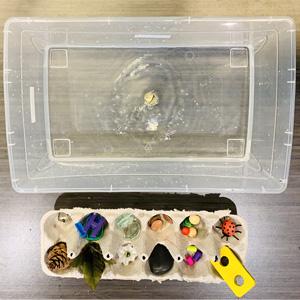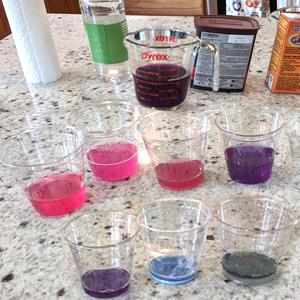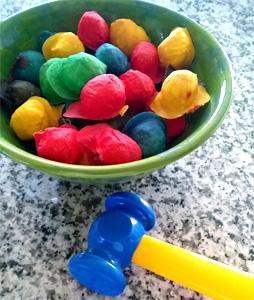Categories
Supplies:
- A container filled with water
- Various objects of different sizes and weights - examples: beads, rocks, pennies, small plastic toys
Directions:
- Drop in objects and observe the effect on the water
- Discuss what you see. Do you notice a ripple? Does it make a splash? What happens if you drop in lots of objects at once?
- Discuss how our behavior and actions also have an effect on the world around us.
- Make a list of acts of kindness you can do.
- Spread the ripple effect of kindness!
Watch this project at: https://www.youtube.com/watch?v=zHM_X3wcmfQ&list=PLMEg2Dd0dSFctLfDQxsL5…
Supplies:
- 2-3 purple cabbage leaves
- 4 cups water
- Blender
- Strainer
- Bowl
- Paper towel
- Several clear containers or cups
- Vinegar
- Baking soda
- Optional: liquid dishwasher detergent, fruit juice, clear soda or carbonated water, soap, salt, other kitchen substances (with grownup approval)
Directions:
- Tear 2 to 3 leaves off the head of a purple cabbage, tear leaves into smaller pieces.
- Put cabbage leaves into a blender with about 4 cups of water and with a grownup's help, blend on high until the liquid is very purple with a few chunks remaining.
- Strain cabbage juice into mesh strainer lined with paper towel, over a large bowl.
- Pour the cabbage juice into a container or pitcher. This purple cabbage juice is now your pH indicator.
Purple cabbage juice contains a compound called anthocyanin. Anthocyanin will turn pink when mixed with acid, blue-green when mixed with a base, and purple when mixed with a neutral substance, such as water. - Take 3-4 additional clear containers: add a spoonful of baking soda to one cup; add a few spoonfuls of vinegar to a second cup; add a bit of water to a third cup.
- Ask your grownup if you can use a small amount of dishwasher detergent into an additional cup.
- Now, you'll add some cabbage juice to each of the four cups you've prepared, even the one that's just water. When the purple cabbage juice is mixed with vinegar, what happens? (You should see the mixture turn pink.) Why? Vinegar is an acid. Pour cabbage juice into the container with baking soda, then also the cup with the dishwasher soap. What is happening to these two solutions? (Baking soda is a base, so it will turn bluish-purple. The dishwasher soap mixture should turn a vivid blue-green because dishwasher soap is very basic, or alkaline.) What happened when you added cabbage juice to just water?
- Line your four cups up on the counter. You will use these color results to compare other substances you want to test to see if they are acids or bases.
- Pink indicates an acid. Place this cup to the left. Purple (water) is neutral. Place this one in the middle. Blue-green is basic. Place this cup to the right of the purple cup. If you used dishwasher detergent, place this cup to the very far right. It’s one of the most alkaline substances you will find in a kitchen.
- Now, try adding purple cabbage juice to other substances you want to test.
- Compare the colors of your test mixtures and place them between the cups, where you think they should go. Soon, you will have a spectrum of acids and bases and you can compare the acidity of two substances, such as vinegar vs. orange juice.
Watch this project at: https://www.youtube.com/watch?v=7nB1UzYZf4s&list=PLMEg2Dd0dSFctLfDQxsL5…
Supplies:
- Cotton balls
- 1 cup flour
- 1 cup water
- Large mixing bowl
- Food coloring
- Baking sheet
- Small bowls or cups
- Either cooking spray or tin foil
- An adult to help with the oven
Directions:
- Mix 1 cup of flour with 1 cup of water in the large bowl.
- Get your baking sheet ready by spraying it with baking spray or covering it with tin foil.
- Divide the flour and water mixture into 4 to 6 small bowls or cups, depending on how many colors you want.
- Add 5 to 8 drops of food coloring to each cup and mix well. Remember that you can make different colors by mixing the food coloring; red and yellow make orange and blue and red make purple.
- Dip each cotton ball into a cup. Be sure to cover the whole cotton ball with the mixture – make it nice and thick.
- Set the coated cotton balls on your baking sheet.
- Let an adult help you with this part. Bake your cotton balls in a 300 degree oven for about 45 minutes.
- After that, take the cotton balls out and let them cool completely – at least an hour. They should have a nice, hard, crunchy shell.
- Find a small hammer, a toy hammer, or even a rock. Take your cotton balls outside and - SMASH THEM WITH THE HAMMER! That’s right – smash away.
Extra fun:
Use more cotton balls to make a baked sculpture. Use the same dipping method, but keep the sculpture in the over a little longer – about 55 minutes. You can make and smash a crunchy monster!
To watch this project visit: https://www.youtube.com/watch?v=Mvw4q6cr6xY&list=PLMEg2Dd0dSFctLfDQxsL5…



 Ruth Holley Library will be temporarily closed for approximately one week starting Mon., Dec. 2 to complete roof repairs.
Ruth Holley Library will be temporarily closed for approximately one week starting Mon., Dec. 2 to complete roof repairs.

